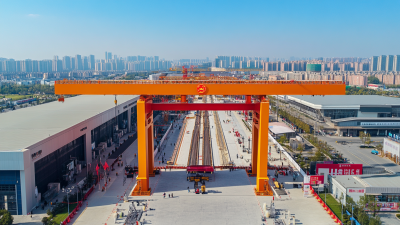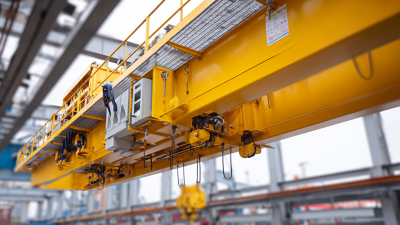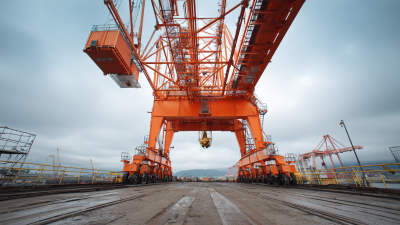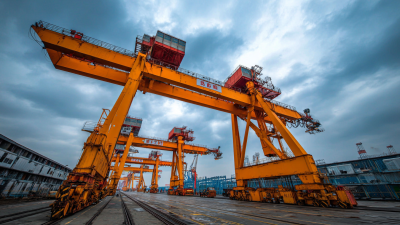Understanding Overhead Gantry Crane Operations and Safety Tips for Modern Industries
In modern industries, the Overhead Gantry Crane plays a crucial role in enhancing operational efficiency and ensuring the safe handling of heavy materials. This versatile lifting equipment is characterized by its dual-girder structure and a bridge that moves along tracks, allowing for the transport of loads over a defined workspace.

Understanding the operational aspects of the Overhead Gantry Crane is essential for maximizing productivity while minimizing risks. With the right approach to safety protocols, operators can navigate the complexities of crane operation, from load balancing to emergency stop procedures.
In this article, we will delve into the intricacies of Overhead Gantry Crane operations, exploring best practices and safety tips tailored to meet the demands of today’s industrial landscape. By prioritizing safety and understanding the mechanisms involved, industries can effectively harness the advantages of this remarkable piece of equipment, facilitating smoother workflows and reducing the likelihood of workplace accidents.
Importance of Overhead Gantry Cranes in Modern Industrial Environments
Overhead gantry cranes play a crucial role in modern industrial environments, providing efficient solutions for heavy lifting and material handling. Their unique design allows them to traverse large areas, making them ideal for warehouses, manufacturing plants, and construction sites. These cranes are equipped with advanced mechanisms that enable them to handle substantial loads smoothly and safely, enhancing productivity while reducing the need for manual labor. By facilitating the movement of heavy materials, overhead gantry cranes contribute significantly to operational efficiency and workflow optimization.
Safety is paramount when operating overhead gantry cranes, given their operational risks and the potential hazards in industrial settings. Proper training for operators, regular maintenance checks, and adherence to safety protocols are essential to prevent accidents and ensure a secure working environment. Additionally, integrating modern technology such as sensor systems and automated controls can further enhance safety and efficiency. As industries continue to evolve, the role of overhead gantry cranes remains indispensable, highlighting their importance in maintaining a streamlined and safe industrial operation.
Overhead Gantry Crane Utilization in Industries
This chart illustrates the utilization rates of overhead gantry cranes across various industries. The automotive and manufacturing sectors showcase the highest utilization, highlighting the essential role of these cranes in ensuring efficiency and safety in modern industrial operations.
Key Operational Principles of Overhead Gantry Crane Systems
Overhead gantry cranes are essential for modern industries, providing robust solutions for lifting and transporting heavy materials. The operational principles of these systems are rooted in their design, which allows for maximum efficiency and safety. Key components include the bridge, which spans the workspace, the hoist responsible for lifting loads, and the trolley that moves along the bridge. These elements work in unison, allowing operators to maneuver heavy objects with precision and control.
Safety is paramount when operating overhead gantry cranes. Operators must be trained to understand load limits, proper signaling, and emergency procedures. Regular maintenance checks are crucial to ensure that all components function correctly and to prevent accidents. Additionally, using proper personal protective equipment (PPE) and adhering to established safety protocols significantly mitigates risks. By prioritizing safety and understanding the key operational principles, industries can maximize the efficiency and lifespan of their gantry crane systems while protecting their workforce.
Common Safety Hazards Associated with Gantry Crane Use
Overhead gantry cranes play an essential role in modern industries, facilitating the movement of heavy materials with efficiency. However, their operation comes with significant safety hazards. Recent reports highlight the prevalent risks faced by crane operators, with falls and struck-by incidents identified as the most frequent causes of injury. Additionally, issues like heat stress and fatigue contribute heavily to accidents, underscoring the need for comprehensive safety measures.
To mitigate these dangers, it is crucial for industries to implement best practices. For instance, establishing designated lift zones can help prevent struck-by incidents. Regular safety training and awareness programs for both employers and employees are also vital. Furthermore, utilizing advanced technologies, as discussed in a recent National Safety Council report, can significantly enhance safety protocols. These technologies provide innovative solutions aimed at reducing the risks inherent to crane operations.
Employers must prioritize the physical wellbeing of operators by integrating fatigue management strategies and ensuring proper hydration practices to combat heat stress. Continuous evaluation and adaptation of safety measures can lead to a safer working environment, ultimately minimizing the risk of serious accidents and fatalities in the crane operation sector.

Best Practices for Ensuring Safety During Crane Operations
Overhead gantry cranes play a pivotal role in modern industries, facilitating the efficient movement of heavy materials. However, with the significant power these machines possess, safety must remain a top priority. According to the U.S. Bureau of Labor Statistics, in 2021, cranes were involved in approximately 44 fatalities in the workplace, underlining the necessity of adhering to safety protocols during operations.
To ensure safety during crane operations, operators should always conduct thorough pre-operation checks. This includes verifying the lifting capacity, inspecting slings, and ensuring that all safety devices are functioning correctly. Additionally, proper training is essential; a report from the National Commission for the Certification of Crane Operators highlights that companies employing certified operators see a 50% reduction in accidents related to crane operations.
Effective communication is another critical safety practice. Operators should establish clear signals with ground personnel before commencing lifts, minimizing the risk of miscommunication. Furthermore, a study by the Occupational Safety and Health Administration (OSHA) emphasizes maintaining a safe working zone around the crane, where bystanders should be restricted to prevent accidents. Implementing these best practices can significantly enhance safety and efficiency in overhead gantry crane operations.
Understanding Overhead Gantry Crane Operations and Safety Tips for Modern Industries
| Operational Aspect | Best Practice | Safety Tip | Frequency of Training |
|---|---|---|---|
| Daily Inspection | Inspect all crane components before use. | Ensure no loose cables or frayed ropes. | Daily |
| Operator Training | Certified training programs for operators. | Follow standard operating procedures. | Annually |
| Load Management | Ensure loads are within crane capacity. | Use load indicators to monitor weights. | Before each lift |
| Clear Communication | Establish hand signals and communication devices. | Use two-way radios for clarity. | Continuous |
| Emergency Procedures | Have a clear plan for emergencies. | Conduct regular drills. | Quarterly |
Training and Certification Requirements for Crane Operators
Training and certification are crucial components in ensuring the safety and efficiency of crane operations in modern industries. Operators of overhead gantry cranes must undergo comprehensive training that covers both theoretical knowledge and practical skills. This training not only familiarizes operators with the crane's mechanics and operational procedures but also emphasizes the importance of safety protocols, load handling techniques, and emergency response strategies. The training is often supplemented by hands-on experience under the supervision of qualified instructors, ensuring that operators can competently manage the equipment in real-world scenarios.

Certification requirements vary by region and industry but generally mandate that crane operators pass both written and practical exams. These certifications ensure that only qualified personnel are entrusted with heavy machinery, which significantly reduces the risk of accidents and enhances workplace safety. Continuous education and periodic recertification are also essential, as they keep operators updated on the latest safety regulations, technological advancements, and best practices in crane operation. Investing in proper training and certification is not merely a legal obligation; it is a vital step towards fostering a culture of safety and professionalism in industries that rely on overhead gantry cranes.
Related Posts
-

Bridge Crane Innovations Take Center Stage at 2025 China Import and Export Fair
-

Exploring the Future of Best Overhead Gantry Cranes: Industry Trends for 2025
-

Future-Proofing Your Operations: 2025 Tech Trends & Effective Strategies for Best Overhead Bridge Crane Usage
-

7 Secrets to Finding the Best Bridge Crane for Your Needs
-

Exploring the Unique Features and Applications of the Best Overhead Gantry Cranes: A Comprehensive Guide
-

How to Safely Operate a Crane Hoist for Maximum Efficiency
